Analysis of Samsung's Global Supply Chain Management: A Report
VerifiedAdded on 2021/11/13
|13
|4447
|131
Report
AI Summary
This report provides a comprehensive analysis of Samsung Electronics' global supply chain management, examining its strategies, risk mitigation, and financial considerations. It begins with an introduction and background of Samsung, highlighting its position as a leader in consumer electronics and its significant revenue contributions. The report delves into a literature review, drawing upon data and insights from industry experts and Samsung's internal policies. It explores Samsung's approach to global coordination, including its adoption of the six sigma approach, advanced planning and scheduling systems, and real-time data management. The report also investigates supply chain risks, such as disruptions from various factors and strategies for managing capacity and protecting intellectual property. Furthermore, it examines Samsung's understanding of finance and its strategies for navigating exchange rate fluctuations and partner relationships. The report concludes by summarizing Samsung's innovative practices and offering key takeaways for business and management professionals.
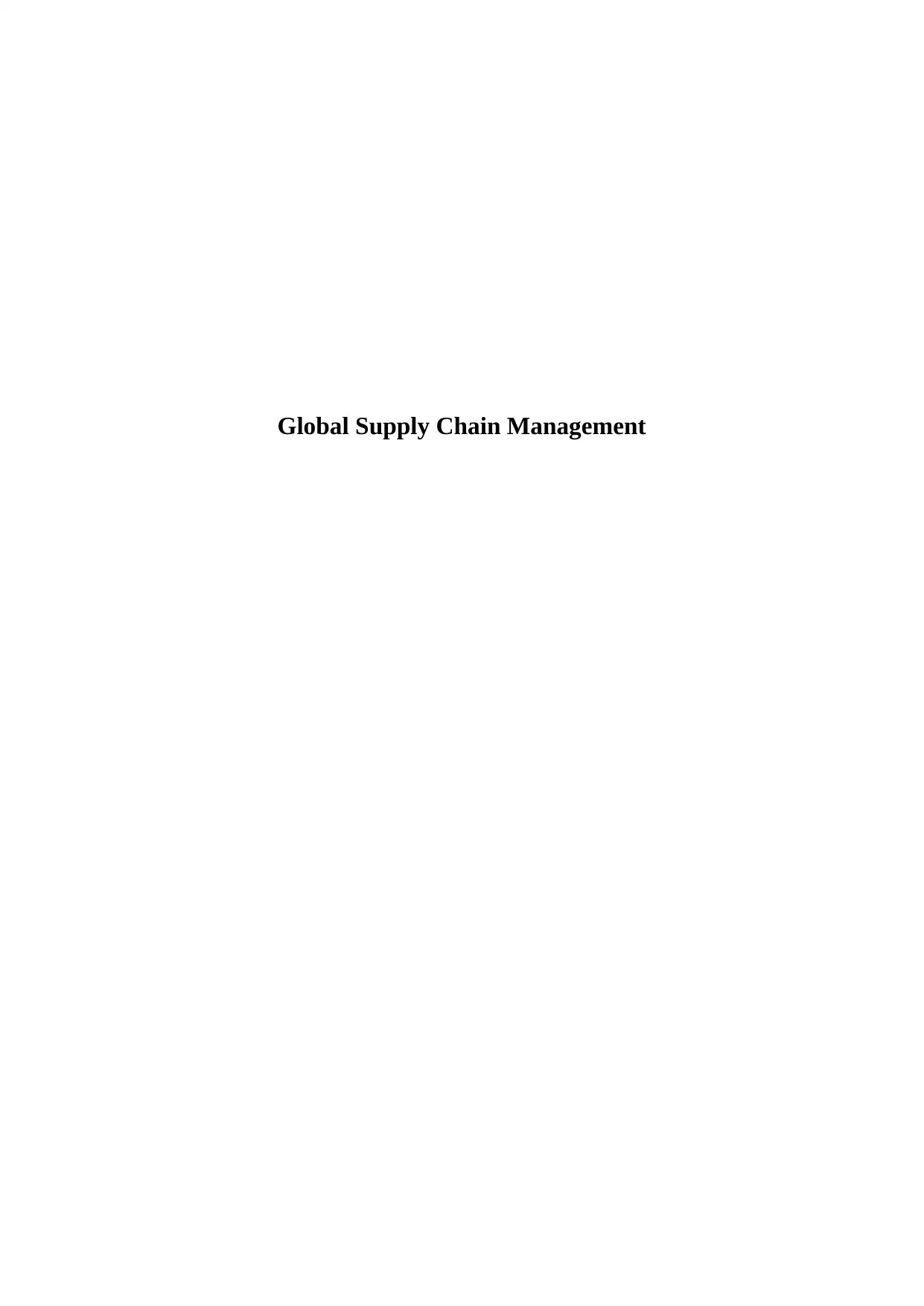
Global Supply Chain Management
Paraphrase This Document
Need a fresh take? Get an instant paraphrase of this document with our AI Paraphraser
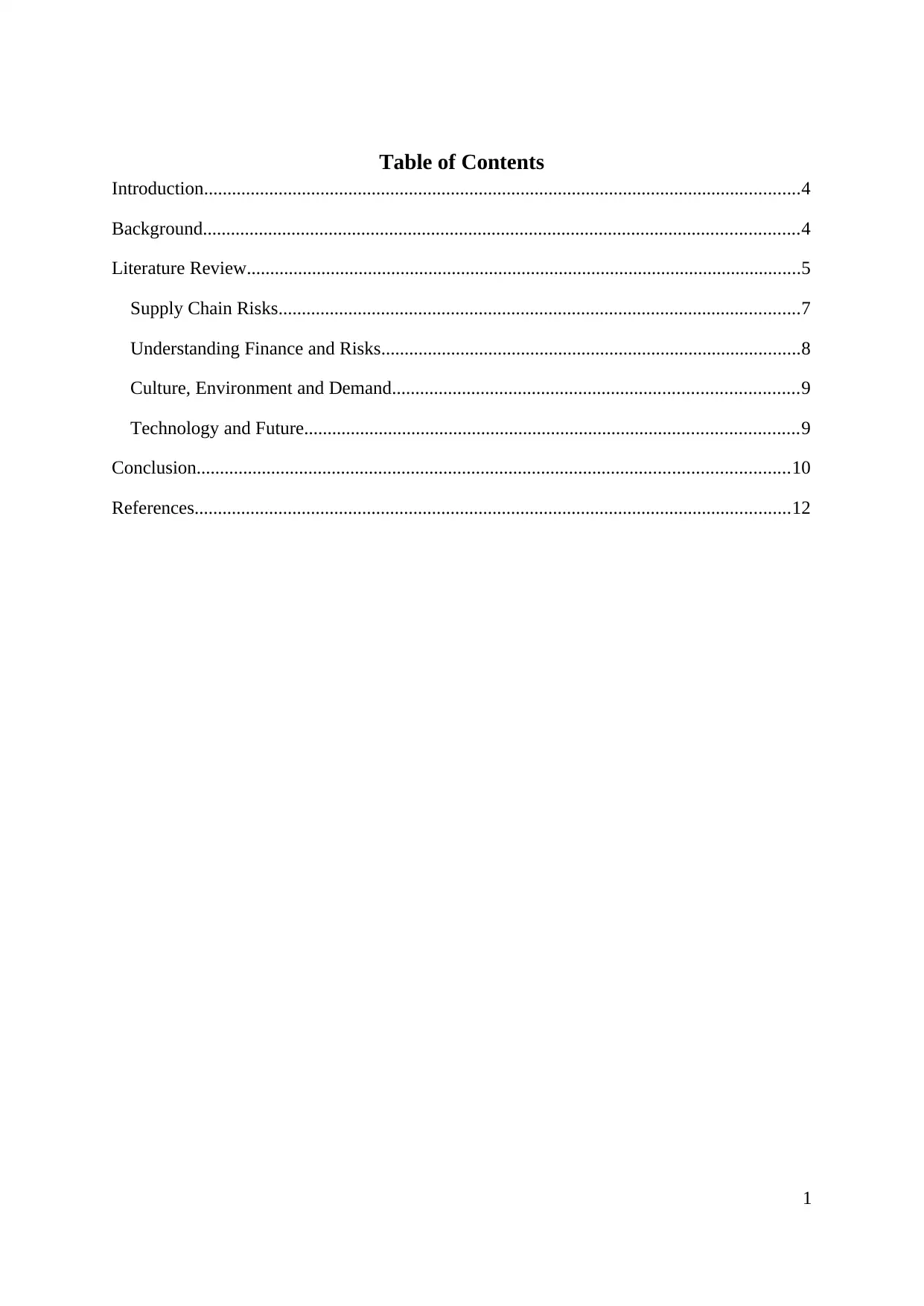
Table of Contents
Introduction................................................................................................................................4
Background................................................................................................................................4
Literature Review.......................................................................................................................5
Supply Chain Risks................................................................................................................7
Understanding Finance and Risks..........................................................................................8
Culture, Environment and Demand.......................................................................................9
Technology and Future..........................................................................................................9
Conclusion...............................................................................................................................10
References................................................................................................................................12
1
Introduction................................................................................................................................4
Background................................................................................................................................4
Literature Review.......................................................................................................................5
Supply Chain Risks................................................................................................................7
Understanding Finance and Risks..........................................................................................8
Culture, Environment and Demand.......................................................................................9
Technology and Future..........................................................................................................9
Conclusion...............................................................................................................................10
References................................................................................................................................12
1
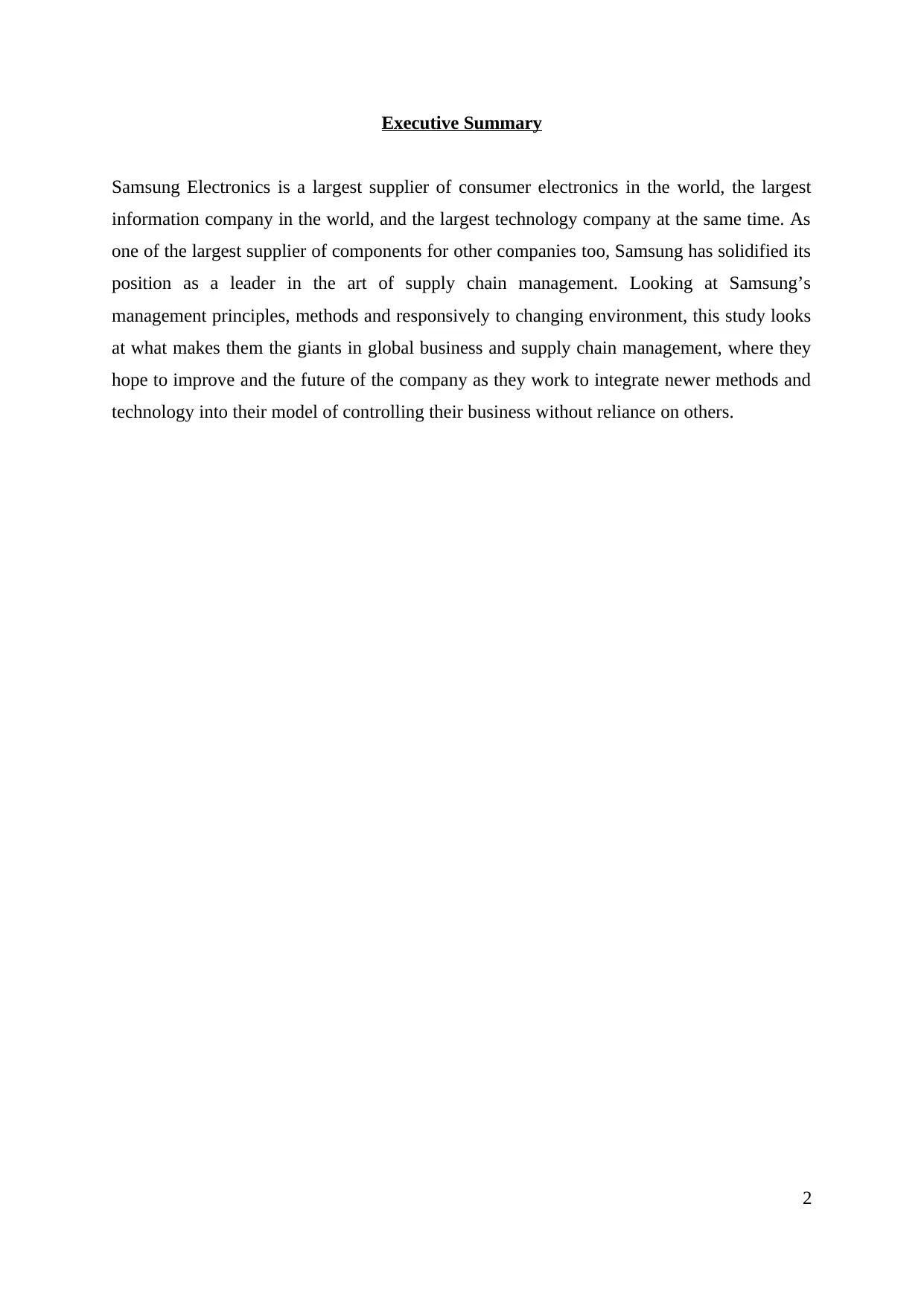
Executive Summary
Samsung Electronics is a largest supplier of consumer electronics in the world, the largest
information company in the world, and the largest technology company at the same time. As
one of the largest supplier of components for other companies too, Samsung has solidified its
position as a leader in the art of supply chain management. Looking at Samsung’s
management principles, methods and responsively to changing environment, this study looks
at what makes them the giants in global business and supply chain management, where they
hope to improve and the future of the company as they work to integrate newer methods and
technology into their model of controlling their business without reliance on others.
2
Samsung Electronics is a largest supplier of consumer electronics in the world, the largest
information company in the world, and the largest technology company at the same time. As
one of the largest supplier of components for other companies too, Samsung has solidified its
position as a leader in the art of supply chain management. Looking at Samsung’s
management principles, methods and responsively to changing environment, this study looks
at what makes them the giants in global business and supply chain management, where they
hope to improve and the future of the company as they work to integrate newer methods and
technology into their model of controlling their business without reliance on others.
2
⊘ This is a preview!⊘
Do you want full access?
Subscribe today to unlock all pages.

Trusted by 1+ million students worldwide
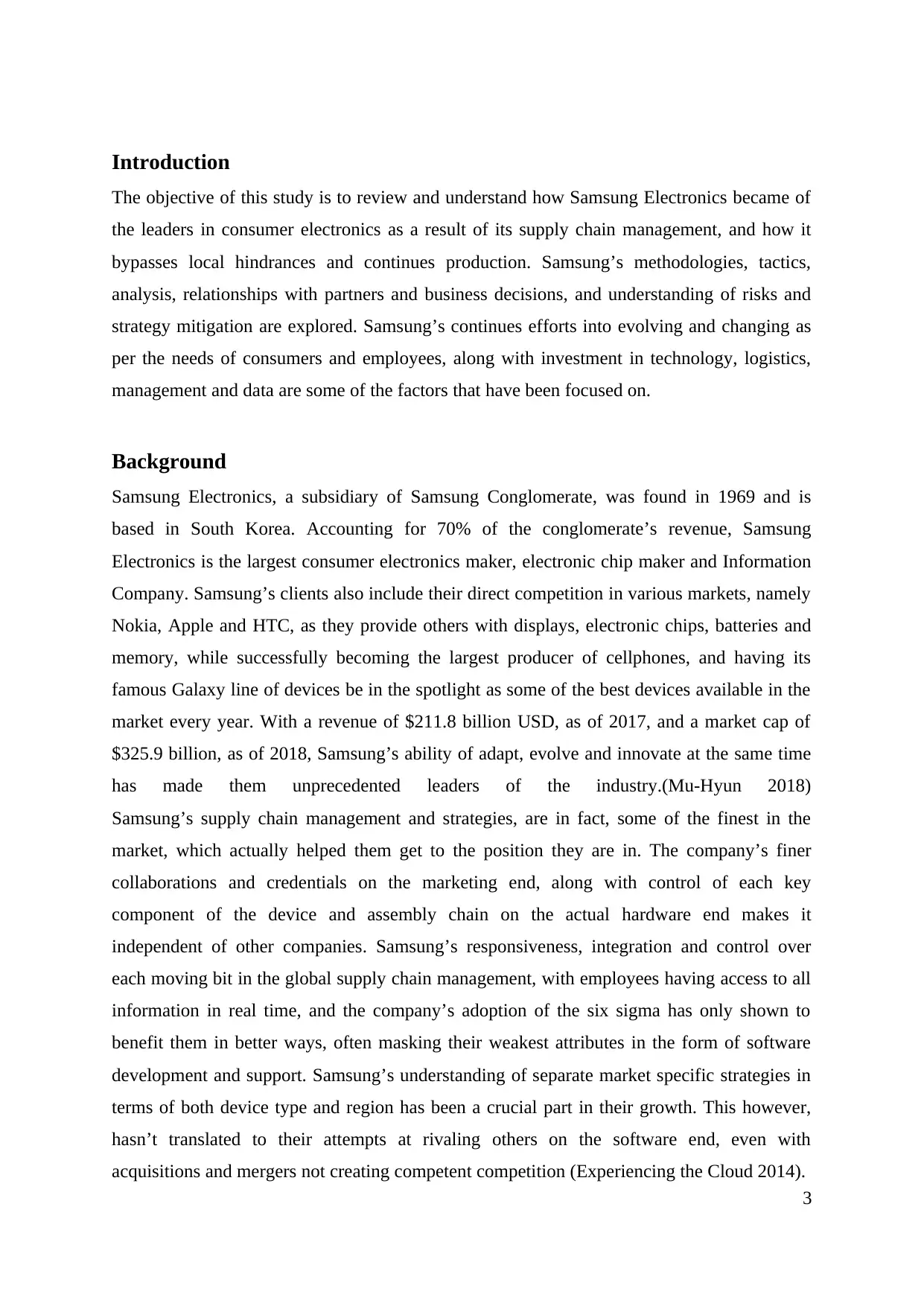
Introduction
The objective of this study is to review and understand how Samsung Electronics became of
the leaders in consumer electronics as a result of its supply chain management, and how it
bypasses local hindrances and continues production. Samsung’s methodologies, tactics,
analysis, relationships with partners and business decisions, and understanding of risks and
strategy mitigation are explored. Samsung’s continues efforts into evolving and changing as
per the needs of consumers and employees, along with investment in technology, logistics,
management and data are some of the factors that have been focused on.
Background
Samsung Electronics, a subsidiary of Samsung Conglomerate, was found in 1969 and is
based in South Korea. Accounting for 70% of the conglomerate’s revenue, Samsung
Electronics is the largest consumer electronics maker, electronic chip maker and Information
Company. Samsung’s clients also include their direct competition in various markets, namely
Nokia, Apple and HTC, as they provide others with displays, electronic chips, batteries and
memory, while successfully becoming the largest producer of cellphones, and having its
famous Galaxy line of devices be in the spotlight as some of the best devices available in the
market every year. With a revenue of $211.8 billion USD, as of 2017, and a market cap of
$325.9 billion, as of 2018, Samsung’s ability of adapt, evolve and innovate at the same time
has made them unprecedented leaders of the industry.(Mu-Hyun 2018)
Samsung’s supply chain management and strategies, are in fact, some of the finest in the
market, which actually helped them get to the position they are in. The company’s finer
collaborations and credentials on the marketing end, along with control of each key
component of the device and assembly chain on the actual hardware end makes it
independent of other companies. Samsung’s responsiveness, integration and control over
each moving bit in the global supply chain management, with employees having access to all
information in real time, and the company’s adoption of the six sigma has only shown to
benefit them in better ways, often masking their weakest attributes in the form of software
development and support. Samsung’s understanding of separate market specific strategies in
terms of both device type and region has been a crucial part in their growth. This however,
hasn’t translated to their attempts at rivaling others on the software end, even with
acquisitions and mergers not creating competent competition (Experiencing the Cloud 2014).
3
The objective of this study is to review and understand how Samsung Electronics became of
the leaders in consumer electronics as a result of its supply chain management, and how it
bypasses local hindrances and continues production. Samsung’s methodologies, tactics,
analysis, relationships with partners and business decisions, and understanding of risks and
strategy mitigation are explored. Samsung’s continues efforts into evolving and changing as
per the needs of consumers and employees, along with investment in technology, logistics,
management and data are some of the factors that have been focused on.
Background
Samsung Electronics, a subsidiary of Samsung Conglomerate, was found in 1969 and is
based in South Korea. Accounting for 70% of the conglomerate’s revenue, Samsung
Electronics is the largest consumer electronics maker, electronic chip maker and Information
Company. Samsung’s clients also include their direct competition in various markets, namely
Nokia, Apple and HTC, as they provide others with displays, electronic chips, batteries and
memory, while successfully becoming the largest producer of cellphones, and having its
famous Galaxy line of devices be in the spotlight as some of the best devices available in the
market every year. With a revenue of $211.8 billion USD, as of 2017, and a market cap of
$325.9 billion, as of 2018, Samsung’s ability of adapt, evolve and innovate at the same time
has made them unprecedented leaders of the industry.(Mu-Hyun 2018)
Samsung’s supply chain management and strategies, are in fact, some of the finest in the
market, which actually helped them get to the position they are in. The company’s finer
collaborations and credentials on the marketing end, along with control of each key
component of the device and assembly chain on the actual hardware end makes it
independent of other companies. Samsung’s responsiveness, integration and control over
each moving bit in the global supply chain management, with employees having access to all
information in real time, and the company’s adoption of the six sigma has only shown to
benefit them in better ways, often masking their weakest attributes in the form of software
development and support. Samsung’s understanding of separate market specific strategies in
terms of both device type and region has been a crucial part in their growth. This however,
hasn’t translated to their attempts at rivaling others on the software end, even with
acquisitions and mergers not creating competent competition (Experiencing the Cloud 2014).
3
Paraphrase This Document
Need a fresh take? Get an instant paraphrase of this document with our AI Paraphraser
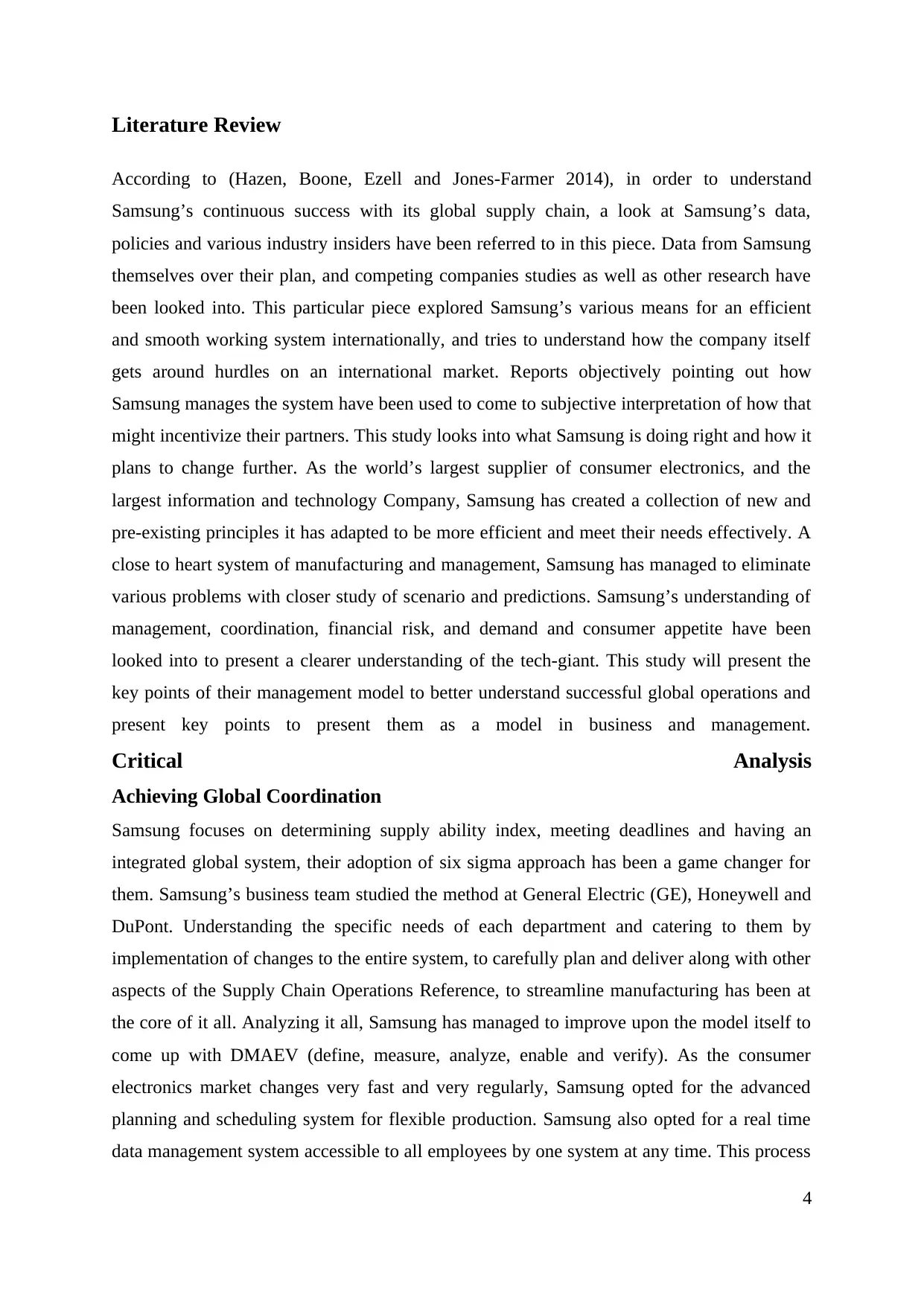
Literature Review
According to (Hazen, Boone, Ezell and Jones-Farmer 2014), in order to understand
Samsung’s continuous success with its global supply chain, a look at Samsung’s data,
policies and various industry insiders have been referred to in this piece. Data from Samsung
themselves over their plan, and competing companies studies as well as other research have
been looked into. This particular piece explored Samsung’s various means for an efficient
and smooth working system internationally, and tries to understand how the company itself
gets around hurdles on an international market. Reports objectively pointing out how
Samsung manages the system have been used to come to subjective interpretation of how that
might incentivize their partners. This study looks into what Samsung is doing right and how it
plans to change further. As the world’s largest supplier of consumer electronics, and the
largest information and technology Company, Samsung has created a collection of new and
pre-existing principles it has adapted to be more efficient and meet their needs effectively. A
close to heart system of manufacturing and management, Samsung has managed to eliminate
various problems with closer study of scenario and predictions. Samsung’s understanding of
management, coordination, financial risk, and demand and consumer appetite have been
looked into to present a clearer understanding of the tech-giant. This study will present the
key points of their management model to better understand successful global operations and
present key points to present them as a model in business and management.
Critical Analysis
Achieving Global Coordination
Samsung focuses on determining supply ability index, meeting deadlines and having an
integrated global system, their adoption of six sigma approach has been a game changer for
them. Samsung’s business team studied the method at General Electric (GE), Honeywell and
DuPont. Understanding the specific needs of each department and catering to them by
implementation of changes to the entire system, to carefully plan and deliver along with other
aspects of the Supply Chain Operations Reference, to streamline manufacturing has been at
the core of it all. Analyzing it all, Samsung has managed to improve upon the model itself to
come up with DMAEV (define, measure, analyze, enable and verify). As the consumer
electronics market changes very fast and very regularly, Samsung opted for the advanced
planning and scheduling system for flexible production. Samsung also opted for a real time
data management system accessible to all employees by one system at any time. This process
4
According to (Hazen, Boone, Ezell and Jones-Farmer 2014), in order to understand
Samsung’s continuous success with its global supply chain, a look at Samsung’s data,
policies and various industry insiders have been referred to in this piece. Data from Samsung
themselves over their plan, and competing companies studies as well as other research have
been looked into. This particular piece explored Samsung’s various means for an efficient
and smooth working system internationally, and tries to understand how the company itself
gets around hurdles on an international market. Reports objectively pointing out how
Samsung manages the system have been used to come to subjective interpretation of how that
might incentivize their partners. This study looks into what Samsung is doing right and how it
plans to change further. As the world’s largest supplier of consumer electronics, and the
largest information and technology Company, Samsung has created a collection of new and
pre-existing principles it has adapted to be more efficient and meet their needs effectively. A
close to heart system of manufacturing and management, Samsung has managed to eliminate
various problems with closer study of scenario and predictions. Samsung’s understanding of
management, coordination, financial risk, and demand and consumer appetite have been
looked into to present a clearer understanding of the tech-giant. This study will present the
key points of their management model to better understand successful global operations and
present key points to present them as a model in business and management.
Critical Analysis
Achieving Global Coordination
Samsung focuses on determining supply ability index, meeting deadlines and having an
integrated global system, their adoption of six sigma approach has been a game changer for
them. Samsung’s business team studied the method at General Electric (GE), Honeywell and
DuPont. Understanding the specific needs of each department and catering to them by
implementation of changes to the entire system, to carefully plan and deliver along with other
aspects of the Supply Chain Operations Reference, to streamline manufacturing has been at
the core of it all. Analyzing it all, Samsung has managed to improve upon the model itself to
come up with DMAEV (define, measure, analyze, enable and verify). As the consumer
electronics market changes very fast and very regularly, Samsung opted for the advanced
planning and scheduling system for flexible production. Samsung also opted for a real time
data management system accessible to all employees by one system at any time. This process
4
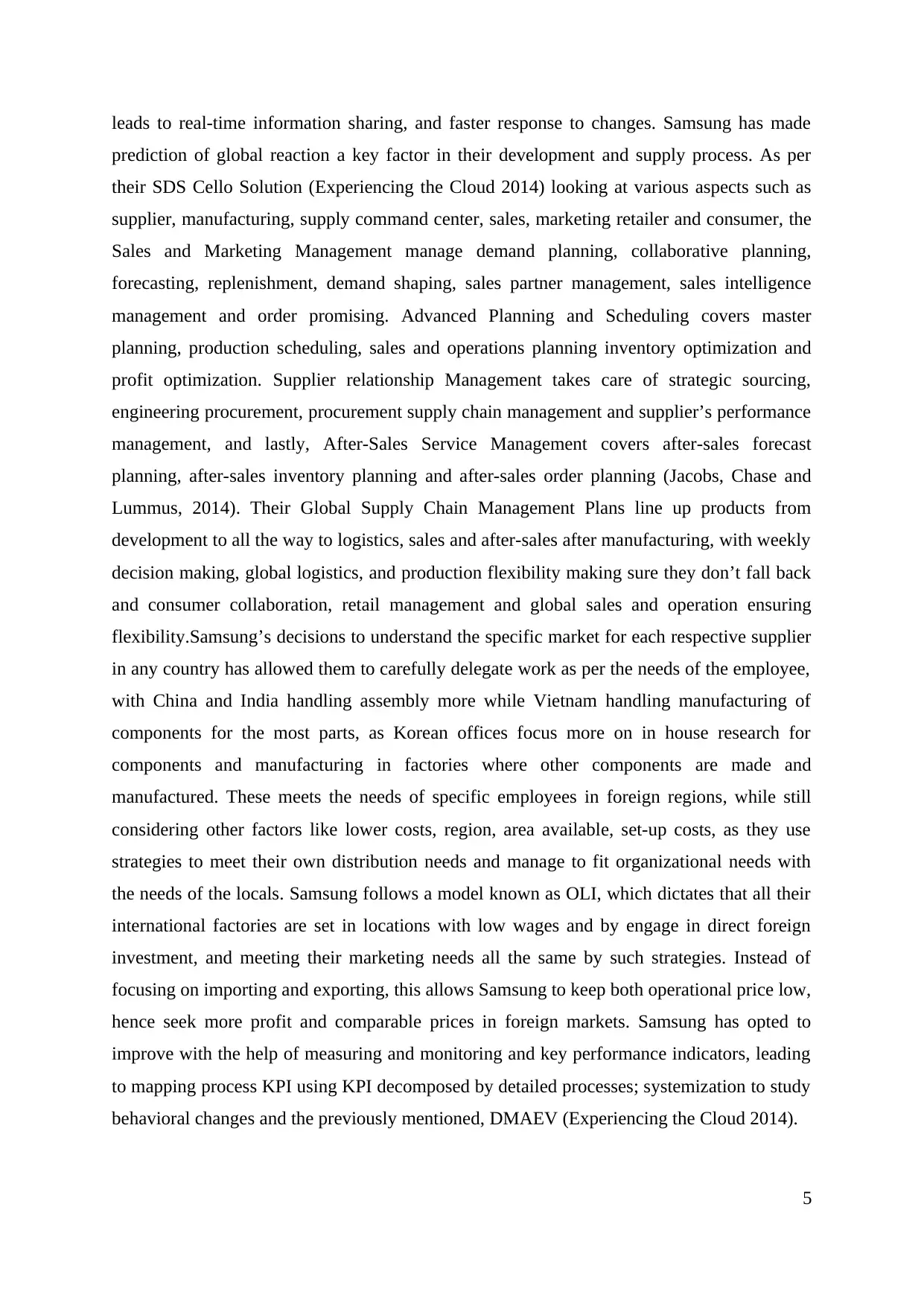
leads to real-time information sharing, and faster response to changes. Samsung has made
prediction of global reaction a key factor in their development and supply process. As per
their SDS Cello Solution (Experiencing the Cloud 2014) looking at various aspects such as
supplier, manufacturing, supply command center, sales, marketing retailer and consumer, the
Sales and Marketing Management manage demand planning, collaborative planning,
forecasting, replenishment, demand shaping, sales partner management, sales intelligence
management and order promising. Advanced Planning and Scheduling covers master
planning, production scheduling, sales and operations planning inventory optimization and
profit optimization. Supplier relationship Management takes care of strategic sourcing,
engineering procurement, procurement supply chain management and supplier’s performance
management, and lastly, After-Sales Service Management covers after-sales forecast
planning, after-sales inventory planning and after-sales order planning (Jacobs, Chase and
Lummus, 2014). Their Global Supply Chain Management Plans line up products from
development to all the way to logistics, sales and after-sales after manufacturing, with weekly
decision making, global logistics, and production flexibility making sure they don’t fall back
and consumer collaboration, retail management and global sales and operation ensuring
flexibility.Samsung’s decisions to understand the specific market for each respective supplier
in any country has allowed them to carefully delegate work as per the needs of the employee,
with China and India handling assembly more while Vietnam handling manufacturing of
components for the most parts, as Korean offices focus more on in house research for
components and manufacturing in factories where other components are made and
manufactured. These meets the needs of specific employees in foreign regions, while still
considering other factors like lower costs, region, area available, set-up costs, as they use
strategies to meet their own distribution needs and manage to fit organizational needs with
the needs of the locals. Samsung follows a model known as OLI, which dictates that all their
international factories are set in locations with low wages and by engage in direct foreign
investment, and meeting their marketing needs all the same by such strategies. Instead of
focusing on importing and exporting, this allows Samsung to keep both operational price low,
hence seek more profit and comparable prices in foreign markets. Samsung has opted to
improve with the help of measuring and monitoring and key performance indicators, leading
to mapping process KPI using KPI decomposed by detailed processes; systemization to study
behavioral changes and the previously mentioned, DMAEV (Experiencing the Cloud 2014).
5
prediction of global reaction a key factor in their development and supply process. As per
their SDS Cello Solution (Experiencing the Cloud 2014) looking at various aspects such as
supplier, manufacturing, supply command center, sales, marketing retailer and consumer, the
Sales and Marketing Management manage demand planning, collaborative planning,
forecasting, replenishment, demand shaping, sales partner management, sales intelligence
management and order promising. Advanced Planning and Scheduling covers master
planning, production scheduling, sales and operations planning inventory optimization and
profit optimization. Supplier relationship Management takes care of strategic sourcing,
engineering procurement, procurement supply chain management and supplier’s performance
management, and lastly, After-Sales Service Management covers after-sales forecast
planning, after-sales inventory planning and after-sales order planning (Jacobs, Chase and
Lummus, 2014). Their Global Supply Chain Management Plans line up products from
development to all the way to logistics, sales and after-sales after manufacturing, with weekly
decision making, global logistics, and production flexibility making sure they don’t fall back
and consumer collaboration, retail management and global sales and operation ensuring
flexibility.Samsung’s decisions to understand the specific market for each respective supplier
in any country has allowed them to carefully delegate work as per the needs of the employee,
with China and India handling assembly more while Vietnam handling manufacturing of
components for the most parts, as Korean offices focus more on in house research for
components and manufacturing in factories where other components are made and
manufactured. These meets the needs of specific employees in foreign regions, while still
considering other factors like lower costs, region, area available, set-up costs, as they use
strategies to meet their own distribution needs and manage to fit organizational needs with
the needs of the locals. Samsung follows a model known as OLI, which dictates that all their
international factories are set in locations with low wages and by engage in direct foreign
investment, and meeting their marketing needs all the same by such strategies. Instead of
focusing on importing and exporting, this allows Samsung to keep both operational price low,
hence seek more profit and comparable prices in foreign markets. Samsung has opted to
improve with the help of measuring and monitoring and key performance indicators, leading
to mapping process KPI using KPI decomposed by detailed processes; systemization to study
behavioral changes and the previously mentioned, DMAEV (Experiencing the Cloud 2014).
5
⊘ This is a preview!⊘
Do you want full access?
Subscribe today to unlock all pages.

Trusted by 1+ million students worldwide
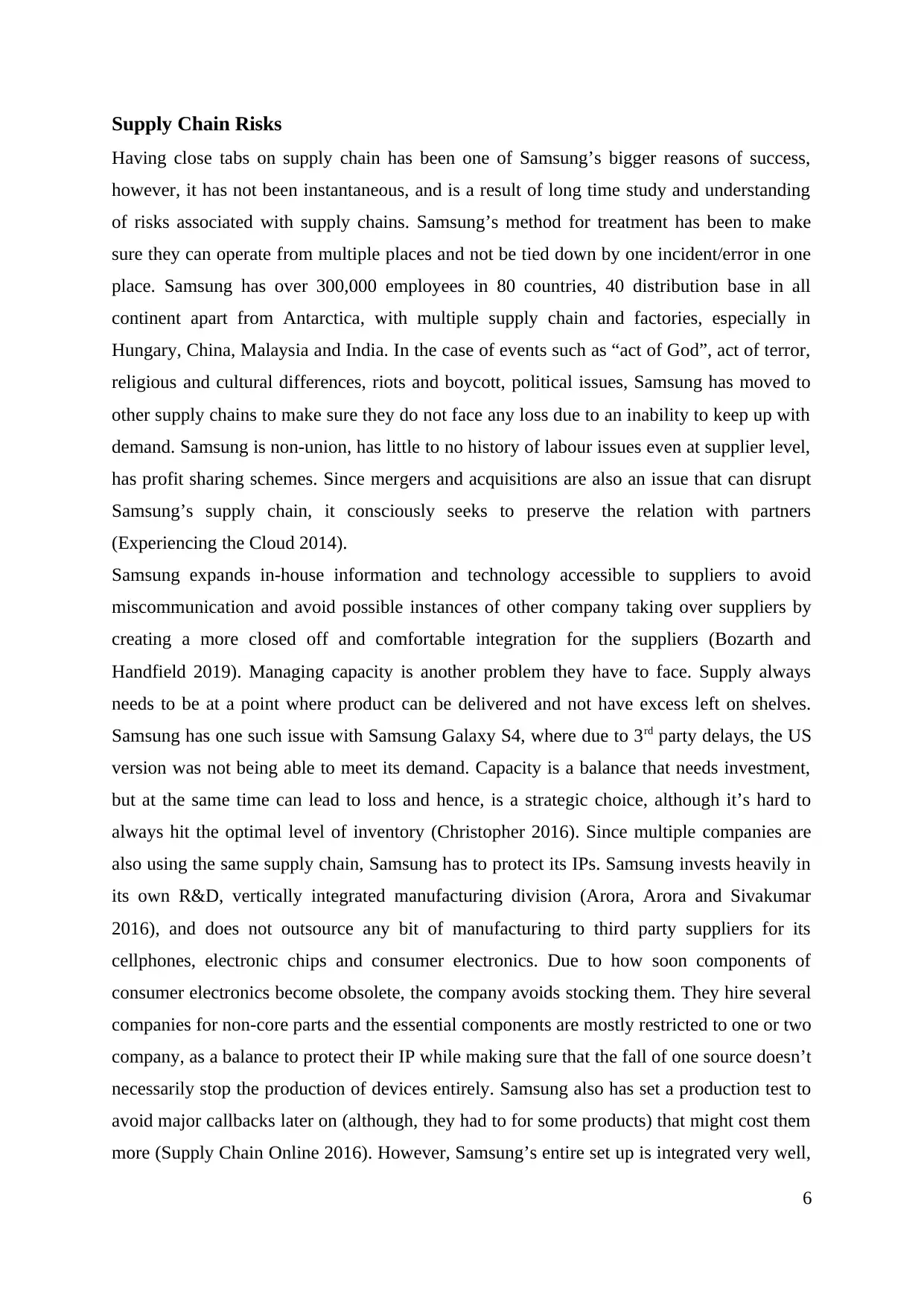
Supply Chain Risks
Having close tabs on supply chain has been one of Samsung’s bigger reasons of success,
however, it has not been instantaneous, and is a result of long time study and understanding
of risks associated with supply chains. Samsung’s method for treatment has been to make
sure they can operate from multiple places and not be tied down by one incident/error in one
place. Samsung has over 300,000 employees in 80 countries, 40 distribution base in all
continent apart from Antarctica, with multiple supply chain and factories, especially in
Hungary, China, Malaysia and India. In the case of events such as “act of God”, act of terror,
religious and cultural differences, riots and boycott, political issues, Samsung has moved to
other supply chains to make sure they do not face any loss due to an inability to keep up with
demand. Samsung is non-union, has little to no history of labour issues even at supplier level,
has profit sharing schemes. Since mergers and acquisitions are also an issue that can disrupt
Samsung’s supply chain, it consciously seeks to preserve the relation with partners
(Experiencing the Cloud 2014).
Samsung expands in-house information and technology accessible to suppliers to avoid
miscommunication and avoid possible instances of other company taking over suppliers by
creating a more closed off and comfortable integration for the suppliers (Bozarth and
Handfield 2019). Managing capacity is another problem they have to face. Supply always
needs to be at a point where product can be delivered and not have excess left on shelves.
Samsung has one such issue with Samsung Galaxy S4, where due to 3rd party delays, the US
version was not being able to meet its demand. Capacity is a balance that needs investment,
but at the same time can lead to loss and hence, is a strategic choice, although it’s hard to
always hit the optimal level of inventory (Christopher 2016). Since multiple companies are
also using the same supply chain, Samsung has to protect its IPs. Samsung invests heavily in
its own R&D, vertically integrated manufacturing division (Arora, Arora and Sivakumar
2016), and does not outsource any bit of manufacturing to third party suppliers for its
cellphones, electronic chips and consumer electronics. Due to how soon components of
consumer electronics become obsolete, the company avoids stocking them. They hire several
companies for non-core parts and the essential components are mostly restricted to one or two
company, as a balance to protect their IP while making sure that the fall of one source doesn’t
necessarily stop the production of devices entirely. Samsung also has set a production test to
avoid major callbacks later on (although, they had to for some products) that might cost them
more (Supply Chain Online 2016). However, Samsung’s entire set up is integrated very well,
6
Having close tabs on supply chain has been one of Samsung’s bigger reasons of success,
however, it has not been instantaneous, and is a result of long time study and understanding
of risks associated with supply chains. Samsung’s method for treatment has been to make
sure they can operate from multiple places and not be tied down by one incident/error in one
place. Samsung has over 300,000 employees in 80 countries, 40 distribution base in all
continent apart from Antarctica, with multiple supply chain and factories, especially in
Hungary, China, Malaysia and India. In the case of events such as “act of God”, act of terror,
religious and cultural differences, riots and boycott, political issues, Samsung has moved to
other supply chains to make sure they do not face any loss due to an inability to keep up with
demand. Samsung is non-union, has little to no history of labour issues even at supplier level,
has profit sharing schemes. Since mergers and acquisitions are also an issue that can disrupt
Samsung’s supply chain, it consciously seeks to preserve the relation with partners
(Experiencing the Cloud 2014).
Samsung expands in-house information and technology accessible to suppliers to avoid
miscommunication and avoid possible instances of other company taking over suppliers by
creating a more closed off and comfortable integration for the suppliers (Bozarth and
Handfield 2019). Managing capacity is another problem they have to face. Supply always
needs to be at a point where product can be delivered and not have excess left on shelves.
Samsung has one such issue with Samsung Galaxy S4, where due to 3rd party delays, the US
version was not being able to meet its demand. Capacity is a balance that needs investment,
but at the same time can lead to loss and hence, is a strategic choice, although it’s hard to
always hit the optimal level of inventory (Christopher 2016). Since multiple companies are
also using the same supply chain, Samsung has to protect its IPs. Samsung invests heavily in
its own R&D, vertically integrated manufacturing division (Arora, Arora and Sivakumar
2016), and does not outsource any bit of manufacturing to third party suppliers for its
cellphones, electronic chips and consumer electronics. Due to how soon components of
consumer electronics become obsolete, the company avoids stocking them. They hire several
companies for non-core parts and the essential components are mostly restricted to one or two
company, as a balance to protect their IP while making sure that the fall of one source doesn’t
necessarily stop the production of devices entirely. Samsung also has set a production test to
avoid major callbacks later on (although, they had to for some products) that might cost them
more (Supply Chain Online 2016). However, Samsung’s entire set up is integrated very well,
6
Paraphrase This Document
Need a fresh take? Get an instant paraphrase of this document with our AI Paraphraser
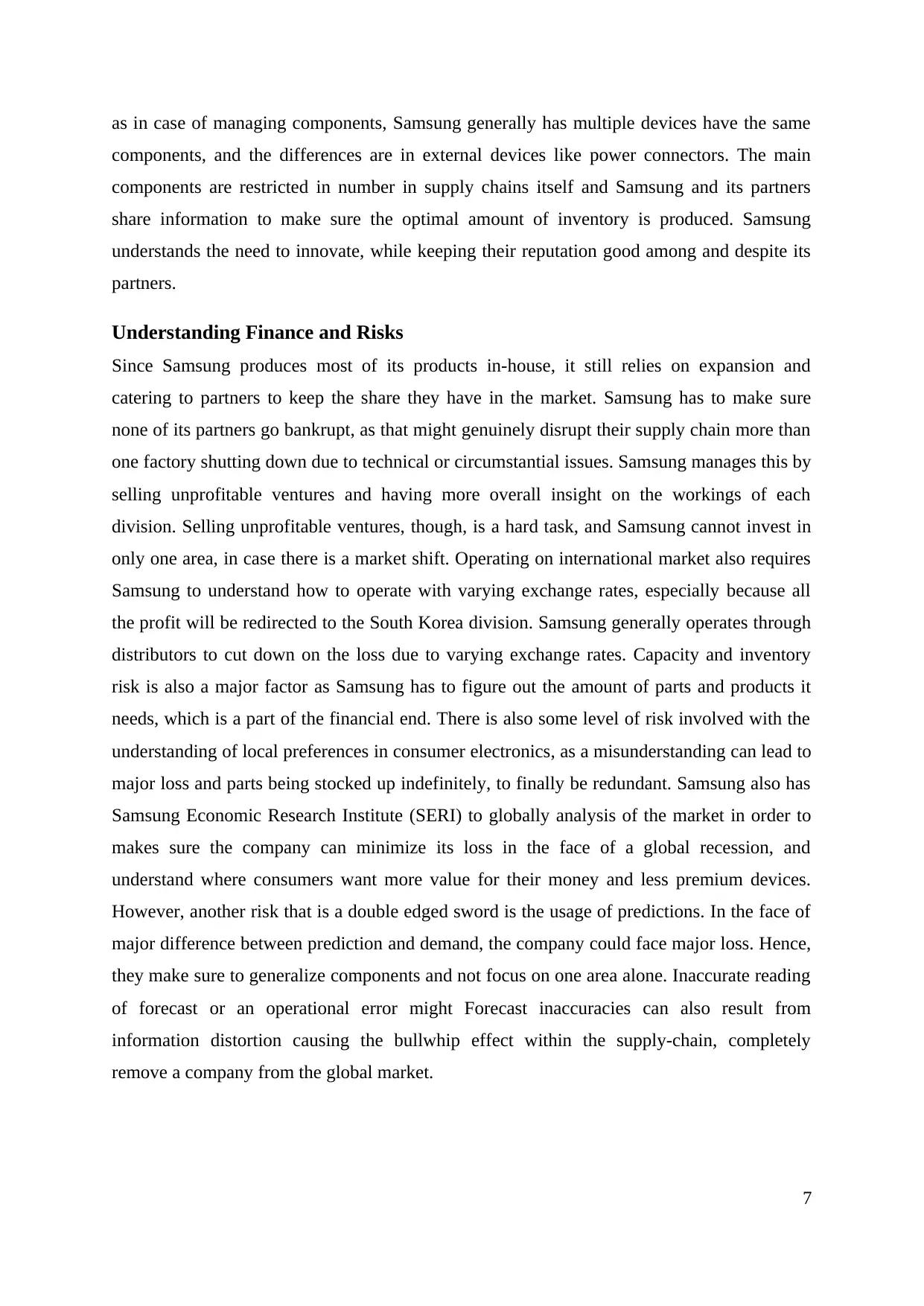
as in case of managing components, Samsung generally has multiple devices have the same
components, and the differences are in external devices like power connectors. The main
components are restricted in number in supply chains itself and Samsung and its partners
share information to make sure the optimal amount of inventory is produced. Samsung
understands the need to innovate, while keeping their reputation good among and despite its
partners.
Understanding Finance and Risks
Since Samsung produces most of its products in-house, it still relies on expansion and
catering to partners to keep the share they have in the market. Samsung has to make sure
none of its partners go bankrupt, as that might genuinely disrupt their supply chain more than
one factory shutting down due to technical or circumstantial issues. Samsung manages this by
selling unprofitable ventures and having more overall insight on the workings of each
division. Selling unprofitable ventures, though, is a hard task, and Samsung cannot invest in
only one area, in case there is a market shift. Operating on international market also requires
Samsung to understand how to operate with varying exchange rates, especially because all
the profit will be redirected to the South Korea division. Samsung generally operates through
distributors to cut down on the loss due to varying exchange rates. Capacity and inventory
risk is also a major factor as Samsung has to figure out the amount of parts and products it
needs, which is a part of the financial end. There is also some level of risk involved with the
understanding of local preferences in consumer electronics, as a misunderstanding can lead to
major loss and parts being stocked up indefinitely, to finally be redundant. Samsung also has
Samsung Economic Research Institute (SERI) to globally analysis of the market in order to
makes sure the company can minimize its loss in the face of a global recession, and
understand where consumers want more value for their money and less premium devices.
However, another risk that is a double edged sword is the usage of predictions. In the face of
major difference between prediction and demand, the company could face major loss. Hence,
they make sure to generalize components and not focus on one area alone. Inaccurate reading
of forecast or an operational error might Forecast inaccuracies can also result from
information distortion causing the bullwhip effect within the supply-chain, completely
remove a company from the global market.
7
components, and the differences are in external devices like power connectors. The main
components are restricted in number in supply chains itself and Samsung and its partners
share information to make sure the optimal amount of inventory is produced. Samsung
understands the need to innovate, while keeping their reputation good among and despite its
partners.
Understanding Finance and Risks
Since Samsung produces most of its products in-house, it still relies on expansion and
catering to partners to keep the share they have in the market. Samsung has to make sure
none of its partners go bankrupt, as that might genuinely disrupt their supply chain more than
one factory shutting down due to technical or circumstantial issues. Samsung manages this by
selling unprofitable ventures and having more overall insight on the workings of each
division. Selling unprofitable ventures, though, is a hard task, and Samsung cannot invest in
only one area, in case there is a market shift. Operating on international market also requires
Samsung to understand how to operate with varying exchange rates, especially because all
the profit will be redirected to the South Korea division. Samsung generally operates through
distributors to cut down on the loss due to varying exchange rates. Capacity and inventory
risk is also a major factor as Samsung has to figure out the amount of parts and products it
needs, which is a part of the financial end. There is also some level of risk involved with the
understanding of local preferences in consumer electronics, as a misunderstanding can lead to
major loss and parts being stocked up indefinitely, to finally be redundant. Samsung also has
Samsung Economic Research Institute (SERI) to globally analysis of the market in order to
makes sure the company can minimize its loss in the face of a global recession, and
understand where consumers want more value for their money and less premium devices.
However, another risk that is a double edged sword is the usage of predictions. In the face of
major difference between prediction and demand, the company could face major loss. Hence,
they make sure to generalize components and not focus on one area alone. Inaccurate reading
of forecast or an operational error might Forecast inaccuracies can also result from
information distortion causing the bullwhip effect within the supply-chain, completely
remove a company from the global market.
7
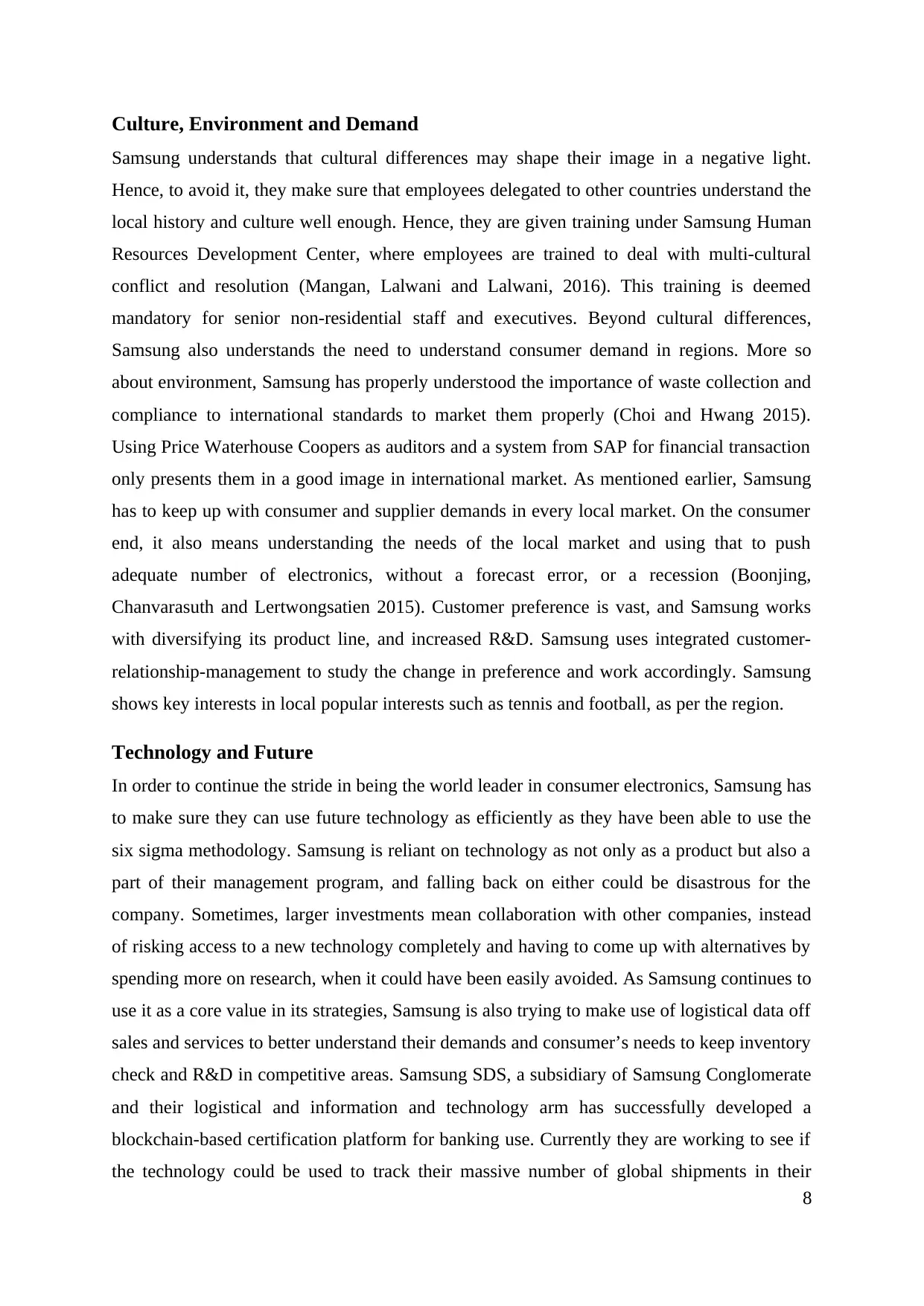
Culture, Environment and Demand
Samsung understands that cultural differences may shape their image in a negative light.
Hence, to avoid it, they make sure that employees delegated to other countries understand the
local history and culture well enough. Hence, they are given training under Samsung Human
Resources Development Center, where employees are trained to deal with multi-cultural
conflict and resolution (Mangan, Lalwani and Lalwani, 2016). This training is deemed
mandatory for senior non-residential staff and executives. Beyond cultural differences,
Samsung also understands the need to understand consumer demand in regions. More so
about environment, Samsung has properly understood the importance of waste collection and
compliance to international standards to market them properly (Choi and Hwang 2015).
Using Price Waterhouse Coopers as auditors and a system from SAP for financial transaction
only presents them in a good image in international market. As mentioned earlier, Samsung
has to keep up with consumer and supplier demands in every local market. On the consumer
end, it also means understanding the needs of the local market and using that to push
adequate number of electronics, without a forecast error, or a recession (Boonjing,
Chanvarasuth and Lertwongsatien 2015). Customer preference is vast, and Samsung works
with diversifying its product line, and increased R&D. Samsung uses integrated customer-
relationship-management to study the change in preference and work accordingly. Samsung
shows key interests in local popular interests such as tennis and football, as per the region.
Technology and Future
In order to continue the stride in being the world leader in consumer electronics, Samsung has
to make sure they can use future technology as efficiently as they have been able to use the
six sigma methodology. Samsung is reliant on technology as not only as a product but also a
part of their management program, and falling back on either could be disastrous for the
company. Sometimes, larger investments mean collaboration with other companies, instead
of risking access to a new technology completely and having to come up with alternatives by
spending more on research, when it could have been easily avoided. As Samsung continues to
use it as a core value in its strategies, Samsung is also trying to make use of logistical data off
sales and services to better understand their demands and consumer’s needs to keep inventory
check and R&D in competitive areas. Samsung SDS, a subsidiary of Samsung Conglomerate
and their logistical and information and technology arm has successfully developed a
blockchain-based certification platform for banking use. Currently they are working to see if
the technology could be used to track their massive number of global shipments in their
8
Samsung understands that cultural differences may shape their image in a negative light.
Hence, to avoid it, they make sure that employees delegated to other countries understand the
local history and culture well enough. Hence, they are given training under Samsung Human
Resources Development Center, where employees are trained to deal with multi-cultural
conflict and resolution (Mangan, Lalwani and Lalwani, 2016). This training is deemed
mandatory for senior non-residential staff and executives. Beyond cultural differences,
Samsung also understands the need to understand consumer demand in regions. More so
about environment, Samsung has properly understood the importance of waste collection and
compliance to international standards to market them properly (Choi and Hwang 2015).
Using Price Waterhouse Coopers as auditors and a system from SAP for financial transaction
only presents them in a good image in international market. As mentioned earlier, Samsung
has to keep up with consumer and supplier demands in every local market. On the consumer
end, it also means understanding the needs of the local market and using that to push
adequate number of electronics, without a forecast error, or a recession (Boonjing,
Chanvarasuth and Lertwongsatien 2015). Customer preference is vast, and Samsung works
with diversifying its product line, and increased R&D. Samsung uses integrated customer-
relationship-management to study the change in preference and work accordingly. Samsung
shows key interests in local popular interests such as tennis and football, as per the region.
Technology and Future
In order to continue the stride in being the world leader in consumer electronics, Samsung has
to make sure they can use future technology as efficiently as they have been able to use the
six sigma methodology. Samsung is reliant on technology as not only as a product but also a
part of their management program, and falling back on either could be disastrous for the
company. Sometimes, larger investments mean collaboration with other companies, instead
of risking access to a new technology completely and having to come up with alternatives by
spending more on research, when it could have been easily avoided. As Samsung continues to
use it as a core value in its strategies, Samsung is also trying to make use of logistical data off
sales and services to better understand their demands and consumer’s needs to keep inventory
check and R&D in competitive areas. Samsung SDS, a subsidiary of Samsung Conglomerate
and their logistical and information and technology arm has successfully developed a
blockchain-based certification platform for banking use. Currently they are working to see if
the technology could be used to track their massive number of global shipments in their
8
⊘ This is a preview!⊘
Do you want full access?
Subscribe today to unlock all pages.

Trusted by 1+ million students worldwide
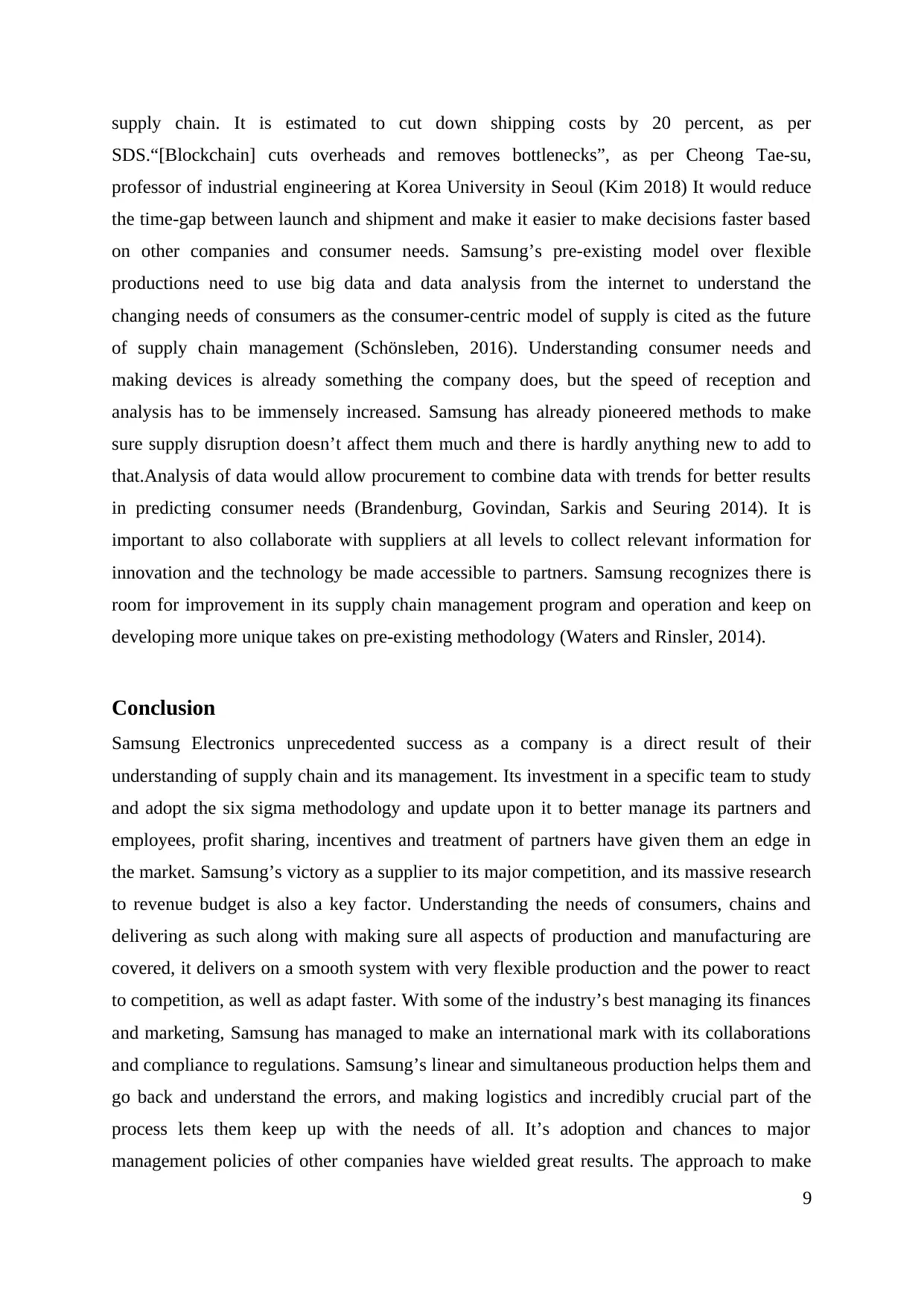
supply chain. It is estimated to cut down shipping costs by 20 percent, as per
SDS.“[Blockchain] cuts overheads and removes bottlenecks”, as per Cheong Tae-su,
professor of industrial engineering at Korea University in Seoul (Kim 2018) It would reduce
the time-gap between launch and shipment and make it easier to make decisions faster based
on other companies and consumer needs. Samsung’s pre-existing model over flexible
productions need to use big data and data analysis from the internet to understand the
changing needs of consumers as the consumer-centric model of supply is cited as the future
of supply chain management (Schönsleben, 2016). Understanding consumer needs and
making devices is already something the company does, but the speed of reception and
analysis has to be immensely increased. Samsung has already pioneered methods to make
sure supply disruption doesn’t affect them much and there is hardly anything new to add to
that.Analysis of data would allow procurement to combine data with trends for better results
in predicting consumer needs (Brandenburg, Govindan, Sarkis and Seuring 2014). It is
important to also collaborate with suppliers at all levels to collect relevant information for
innovation and the technology be made accessible to partners. Samsung recognizes there is
room for improvement in its supply chain management program and operation and keep on
developing more unique takes on pre-existing methodology (Waters and Rinsler, 2014).
Conclusion
Samsung Electronics unprecedented success as a company is a direct result of their
understanding of supply chain and its management. Its investment in a specific team to study
and adopt the six sigma methodology and update upon it to better manage its partners and
employees, profit sharing, incentives and treatment of partners have given them an edge in
the market. Samsung’s victory as a supplier to its major competition, and its massive research
to revenue budget is also a key factor. Understanding the needs of consumers, chains and
delivering as such along with making sure all aspects of production and manufacturing are
covered, it delivers on a smooth system with very flexible production and the power to react
to competition, as well as adapt faster. With some of the industry’s best managing its finances
and marketing, Samsung has managed to make an international mark with its collaborations
and compliance to regulations. Samsung’s linear and simultaneous production helps them and
go back and understand the errors, and making logistics and incredibly crucial part of the
process lets them keep up with the needs of all. It’s adoption and chances to major
management policies of other companies have wielded great results. The approach to make
9
SDS.“[Blockchain] cuts overheads and removes bottlenecks”, as per Cheong Tae-su,
professor of industrial engineering at Korea University in Seoul (Kim 2018) It would reduce
the time-gap between launch and shipment and make it easier to make decisions faster based
on other companies and consumer needs. Samsung’s pre-existing model over flexible
productions need to use big data and data analysis from the internet to understand the
changing needs of consumers as the consumer-centric model of supply is cited as the future
of supply chain management (Schönsleben, 2016). Understanding consumer needs and
making devices is already something the company does, but the speed of reception and
analysis has to be immensely increased. Samsung has already pioneered methods to make
sure supply disruption doesn’t affect them much and there is hardly anything new to add to
that.Analysis of data would allow procurement to combine data with trends for better results
in predicting consumer needs (Brandenburg, Govindan, Sarkis and Seuring 2014). It is
important to also collaborate with suppliers at all levels to collect relevant information for
innovation and the technology be made accessible to partners. Samsung recognizes there is
room for improvement in its supply chain management program and operation and keep on
developing more unique takes on pre-existing methodology (Waters and Rinsler, 2014).
Conclusion
Samsung Electronics unprecedented success as a company is a direct result of their
understanding of supply chain and its management. Its investment in a specific team to study
and adopt the six sigma methodology and update upon it to better manage its partners and
employees, profit sharing, incentives and treatment of partners have given them an edge in
the market. Samsung’s victory as a supplier to its major competition, and its massive research
to revenue budget is also a key factor. Understanding the needs of consumers, chains and
delivering as such along with making sure all aspects of production and manufacturing are
covered, it delivers on a smooth system with very flexible production and the power to react
to competition, as well as adapt faster. With some of the industry’s best managing its finances
and marketing, Samsung has managed to make an international mark with its collaborations
and compliance to regulations. Samsung’s linear and simultaneous production helps them and
go back and understand the errors, and making logistics and incredibly crucial part of the
process lets them keep up with the needs of all. It’s adoption and chances to major
management policies of other companies have wielded great results. The approach to make
9
Paraphrase This Document
Need a fresh take? Get an instant paraphrase of this document with our AI Paraphraser
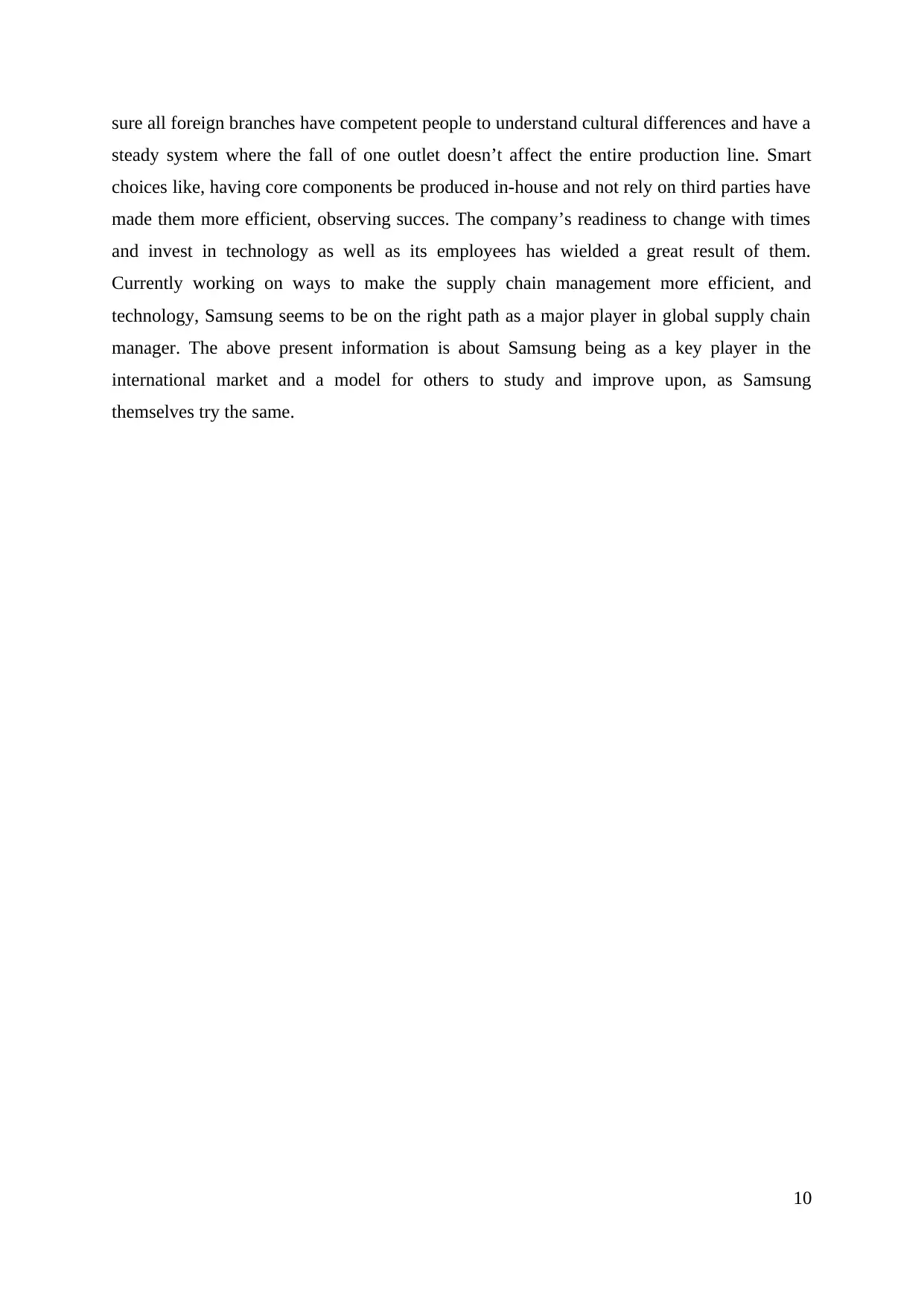
sure all foreign branches have competent people to understand cultural differences and have a
steady system where the fall of one outlet doesn’t affect the entire production line. Smart
choices like, having core components be produced in-house and not rely on third parties have
made them more efficient, observing succes. The company’s readiness to change with times
and invest in technology as well as its employees has wielded a great result of them.
Currently working on ways to make the supply chain management more efficient, and
technology, Samsung seems to be on the right path as a major player in global supply chain
manager. The above present information is about Samsung being as a key player in the
international market and a model for others to study and improve upon, as Samsung
themselves try the same.
10
steady system where the fall of one outlet doesn’t affect the entire production line. Smart
choices like, having core components be produced in-house and not rely on third parties have
made them more efficient, observing succes. The company’s readiness to change with times
and invest in technology as well as its employees has wielded a great result of them.
Currently working on ways to make the supply chain management more efficient, and
technology, Samsung seems to be on the right path as a major player in global supply chain
manager. The above present information is about Samsung being as a key player in the
international market and a model for others to study and improve upon, as Samsung
themselves try the same.
10
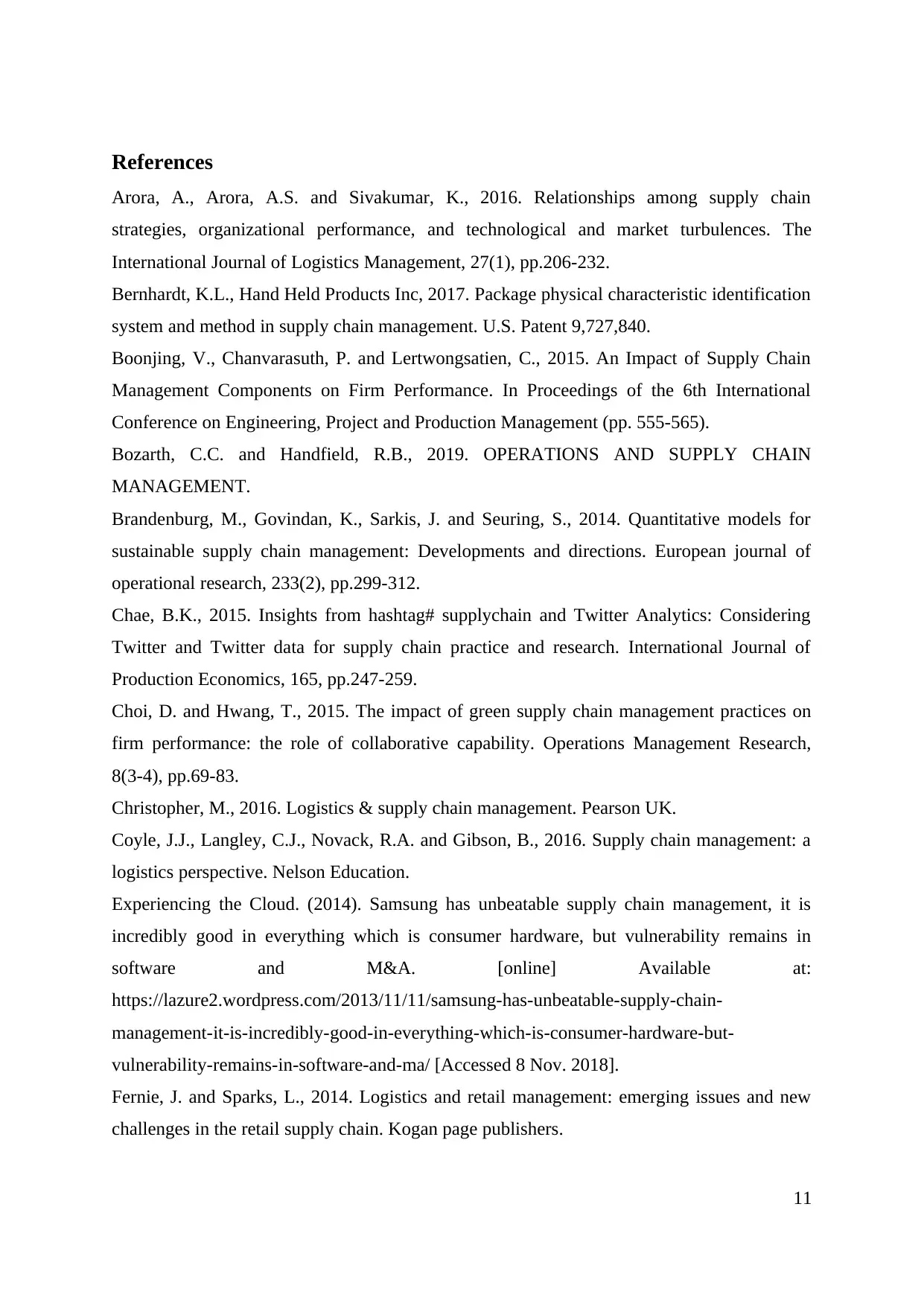
References
Arora, A., Arora, A.S. and Sivakumar, K., 2016. Relationships among supply chain
strategies, organizational performance, and technological and market turbulences. The
International Journal of Logistics Management, 27(1), pp.206-232.
Bernhardt, K.L., Hand Held Products Inc, 2017. Package physical characteristic identification
system and method in supply chain management. U.S. Patent 9,727,840.
Boonjing, V., Chanvarasuth, P. and Lertwongsatien, C., 2015. An Impact of Supply Chain
Management Components on Firm Performance. In Proceedings of the 6th International
Conference on Engineering, Project and Production Management (pp. 555-565).
Bozarth, C.C. and Handfield, R.B., 2019. OPERATIONS AND SUPPLY CHAIN
MANAGEMENT.
Brandenburg, M., Govindan, K., Sarkis, J. and Seuring, S., 2014. Quantitative models for
sustainable supply chain management: Developments and directions. European journal of
operational research, 233(2), pp.299-312.
Chae, B.K., 2015. Insights from hashtag# supplychain and Twitter Analytics: Considering
Twitter and Twitter data for supply chain practice and research. International Journal of
Production Economics, 165, pp.247-259.
Choi, D. and Hwang, T., 2015. The impact of green supply chain management practices on
firm performance: the role of collaborative capability. Operations Management Research,
8(3-4), pp.69-83.
Christopher, M., 2016. Logistics & supply chain management. Pearson UK.
Coyle, J.J., Langley, C.J., Novack, R.A. and Gibson, B., 2016. Supply chain management: a
logistics perspective. Nelson Education.
Experiencing the Cloud. (2014). Samsung has unbeatable supply chain management, it is
incredibly good in everything which is consumer hardware, but vulnerability remains in
software and M&A. [online] Available at:
https://lazure2.wordpress.com/2013/11/11/samsung-has-unbeatable-supply-chain-
management-it-is-incredibly-good-in-everything-which-is-consumer-hardware-but-
vulnerability-remains-in-software-and-ma/ [Accessed 8 Nov. 2018].
Fernie, J. and Sparks, L., 2014. Logistics and retail management: emerging issues and new
challenges in the retail supply chain. Kogan page publishers.
11
Arora, A., Arora, A.S. and Sivakumar, K., 2016. Relationships among supply chain
strategies, organizational performance, and technological and market turbulences. The
International Journal of Logistics Management, 27(1), pp.206-232.
Bernhardt, K.L., Hand Held Products Inc, 2017. Package physical characteristic identification
system and method in supply chain management. U.S. Patent 9,727,840.
Boonjing, V., Chanvarasuth, P. and Lertwongsatien, C., 2015. An Impact of Supply Chain
Management Components on Firm Performance. In Proceedings of the 6th International
Conference on Engineering, Project and Production Management (pp. 555-565).
Bozarth, C.C. and Handfield, R.B., 2019. OPERATIONS AND SUPPLY CHAIN
MANAGEMENT.
Brandenburg, M., Govindan, K., Sarkis, J. and Seuring, S., 2014. Quantitative models for
sustainable supply chain management: Developments and directions. European journal of
operational research, 233(2), pp.299-312.
Chae, B.K., 2015. Insights from hashtag# supplychain and Twitter Analytics: Considering
Twitter and Twitter data for supply chain practice and research. International Journal of
Production Economics, 165, pp.247-259.
Choi, D. and Hwang, T., 2015. The impact of green supply chain management practices on
firm performance: the role of collaborative capability. Operations Management Research,
8(3-4), pp.69-83.
Christopher, M., 2016. Logistics & supply chain management. Pearson UK.
Coyle, J.J., Langley, C.J., Novack, R.A. and Gibson, B., 2016. Supply chain management: a
logistics perspective. Nelson Education.
Experiencing the Cloud. (2014). Samsung has unbeatable supply chain management, it is
incredibly good in everything which is consumer hardware, but vulnerability remains in
software and M&A. [online] Available at:
https://lazure2.wordpress.com/2013/11/11/samsung-has-unbeatable-supply-chain-
management-it-is-incredibly-good-in-everything-which-is-consumer-hardware-but-
vulnerability-remains-in-software-and-ma/ [Accessed 8 Nov. 2018].
Fernie, J. and Sparks, L., 2014. Logistics and retail management: emerging issues and new
challenges in the retail supply chain. Kogan page publishers.
11
⊘ This is a preview!⊘
Do you want full access?
Subscribe today to unlock all pages.

Trusted by 1+ million students worldwide
1 out of 13
Related Documents
Your All-in-One AI-Powered Toolkit for Academic Success.
+13062052269
info@desklib.com
Available 24*7 on WhatsApp / Email
![[object Object]](/_next/static/media/star-bottom.7253800d.svg)
Unlock your academic potential
Copyright © 2020–2025 A2Z Services. All Rights Reserved. Developed and managed by ZUCOL.




